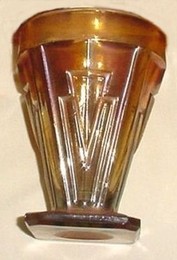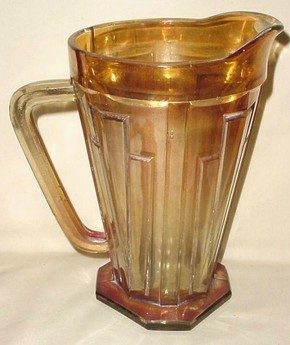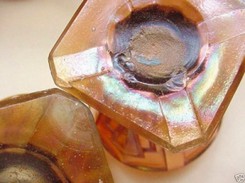Decorama - Josef Inwald and South American copies
Thanks to Maria Lorena Piotrowski, Buenos Aires - "divinnecollection" on eBay - for use of her photos.
|
The Czech glassmaker, Josef Inwald, made a splendid Art Deco style pattern known originally as "Sphinx", but known to collectors today as Decorama. Water sets and a carafe are known - see Inwald's 1933 catalogue on the right.
They are found in the fabulous marigold that is typical of the high quality iridescence we have come to associate with Inwald. But could Inwald's Decorama have been copied? Decorama tumblers in blue Carnival appeared on the market in 2008 and 2009, yet Inwald’s Carnival production has only been known in marigold, although we recently discovered that Inwald made a few rare items in soft pink-amethyst and soft blue shades called Azurit Irisé. Full details of this Inwald discovery can be found here. |
|
However, the likely answer seems to be that Inwald’s Decorama pattern was actually copied by one of the South American Carnival Glass makers, who are well known for making blue Carnival.
Evidence for this lies not only in the blue colour, but also in the shape and pattern of the Decorama items that have been found in South America. The shape of the Decorama water pitcher found in Argentina is not the same as the Inwald original; the handle is totally different and there are other small variations. We can also see some subtle differences in the patterns on the tumblers: on the Inwald original, the vertical lines in the pattern meet in a V shape above the foot while on the tumblers that we believe are South American copies, the same vertical lines go down onto the foot without meeting in a V. The pictures below clearly show these differences. |
|
Further striking differences can be observed in the quality of the items.
Signature characteristics of Inwald’s Carnival are top notch iridescence and a mirror shiny base grind. These are not present on the items we believe are the South American version. The pictures show Inwald's typical shiny, polished base (near right, on a Nola tumbler), compared with the rougher, "as moulded" base of the South American version on the far right. |
We know that there were many links between Czechoslovakia and South America and that the glass companies perpetuated those links through trade connections and more. The Inwald and Rindskopf companies merged in the early 1930s (although each kept their separate identities) and shortly afterwards, one of Josef Rindskopf’s sons (Sherman) actually went to live in South America.
See more Collectors Facts
See more Collectors Facts






